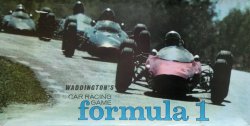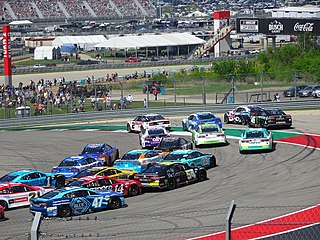
Auto racing is a motorsport involving the racing of automobiles for competition. In North America, the term is commonly used to describe all forms of automobile sport including non-racing disciplines.

A speedometer or speed meter is a gauge that measures and displays the instantaneous speed of a vehicle. Now universally fitted to motor vehicles, they started to be available as options in the early 20th century, and as standard equipment from about 1910 onwards. Other vehicles may use devices analogous to the speedometer with different means of sensing speed, eg. boats use a pit log, while aircraft use an airspeed indicator.
A Formula One car or F1 car is a single-seat, open-cockpit, open-wheel formula racing car with substantial front and rear wings, and an engine positioned behind the driver, intended to be used in competition at Formula One racing events. The regulations governing the cars are unique to the championship and specify that cars must be constructed by the racing teams themselves, though the design and manufacture can be outsourced. Formula One drivers experience peak cornering forces of up to six lateral g.

A dashboard is a control panel set within the central console of a vehicle, boat, or cockpit of an aircraft or spacecraft. Usually located directly ahead of the driver, it displays instrumentation and controls for the vehicle's operation. An electronic equivalent may be called an electronic instrument cluster, digital instrument panel, digital dash, digital speedometer or digital instrument cluster. By analogy, a succinct display of various types of related visual data in one place is also called a dashboard.

In motorsports, a pit stop is a pause for refuelling, new tyres, repairs, mechanical adjustments, a driver change, as a penalty, or any combination of the above. These stops occur in an area called the pits, most commonly accessed via a pit lane which runs parallel to the start/finish straightaway of the track and is connected to it at each end. Along this lane is a row of garages outside which the work is done in a pit box. Pit stop work is carried out by the pit crew of up to twenty mechanics, depending on the series regulations, while the driver often waits in the vehicle.

The Monza Circuit is a 5.793 km (3.600 mi) race track near the city of Monza, north of Milan, in Italy. Built in 1922, it was the world's third purpose-built motor racing circuit after Brooklands and Indianapolis and the oldest in mainland Europe. The circuit's biggest event is the Italian Grand Prix. With the exception of the 1980 running when the track was closed while undergoing refurbishment, the race has been hosted there since 1949. The circuit is also known as "The Temple of Speed" due to its long straights and high-speed corners.
Leslie George Johnson was a British racing driver who competed in rallies, hill climbs, sports car races and Grand Prix races.

The MGB is a two-door sports car manufactured and marketed from 1962 until 1980 by the British Motor Corporation (BMC), later the Austin-Morris division of British Leyland, as a four-cylinder, soft-top sports car. It was announced and its details first published on 19 September 1962. Variants include the MGB GT three-door 2+2 coupé (1965–1980), the six-cylinder sports car and coupé MGC (1967–1969), and the eight-cylinder 2+2 coupé, the MGB GT V8 (1973–1976).

Formula D is a board game that recreates formula racing. It was designed by Eric Randall and Laurent Lavaur and was originally published by Ludodélire. The rights to the game passed to EuroGames with the collapse of Ludodélire, and were in turn acquired by Asmodée Éditions. When Asmodée released their new edition, the game's name was shortened to Formula D and its rules updated to include street and import racing.

The Riley One-Point-Five and similar Wolseley 1500 are cars produced by Riley and Wolseley respectively from 1957 until 1965. They utilised the Morris Minor floorpan, suspension and steering but were fitted with the larger 1,489 cc (90.9 cu in) B-Series engine and MG Magnette gearbox.

Alfa Romeo Giulia is the name of three not directly related models by the Italian car manufacturer Alfa Romeo. The first is a line of sporty four-door compact executive cars produced from 1962 to 1978, the second is an updated, mainly up-engined Spider, Sprint and Sprint Speciale Giuliettas, and the third Giulia is a compact executive car unveiled in 2015.

A parade lap, also known as a pace lap, formation lap or warm-up lap, is a lap before a motorsport race begins, in which the drivers go around the track at a slow speed, and, in some cases, behind the safety car.
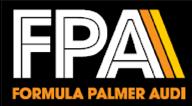
Formula Palmer Audi, officially abbreviated to FPA, and sometimes informally abbreviated to Palmer Audi, was a one-make class of open wheel Formula racing founded in 1998 by former Formula One driver, Jonathan Palmer. It was based in the United Kingdom (UK), and was organised and operated by MotorSport Vision. It had a high proportion of British drivers and venues, but it also featured international drivers and races in mainland Europe.
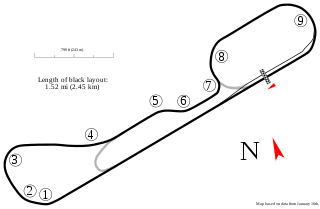
The Adelaide International Raceway is a permanent circuit owned by Australian Motorsport Club Limited under the auspices of the Bob Jane Corporation. The circuit is located 26 km (16 mi) north of Adelaide in South Australia on Port Wakefield Road at Virginia, and is adjacent to Adelaide's premier car racing Dirt track racing venue, Speedway City. AIR is owned by the Bob Jane Corporation and run by the Australian Motorsport Club Ltd.

Live for Speed (LFS) is a racing simulator developed by a three-person team comprising Scawen Roberts, Eric Bailey, and Victor van Vlaardingen. The main focus is to provide a realistic racing experience for the online multiplayer game and to allow single player races against AI cars. Users can set personal bests which can then be uploaded to LFSWorld in hotlap mode, and take driving lessons in 'training' mode.
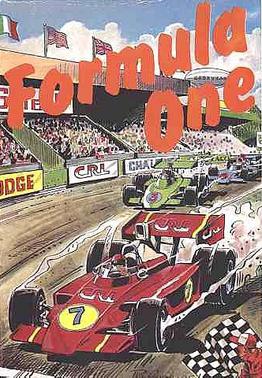
Formula One is a Formula One racing management video game published in 1985 by CRL Group PLC. It was developed by G.B. Munday and B.P. Wheelhouse for the ZX Spectrum, and converted to Amstrad CPC by Richard Taylor.

Speed Circuit is a Formula I racing game published by 3M in 1971, and then republished by Avalon Hill in 1977.

The Spark-Renault SRT_01E, also known as the SRT01-e or the Spark Gen1, was an electric formula race car designed for the inaugural season of Formula E, in 2014–15. The car was the result of a 10-month collaboration between Spark Racing Technology, McLaren Electronic Systems, Williams Advanced Engineering, Dallara and Renault. The car was used until the end of Formula E's fourth season in 2018, after which it was replaced by the SRT05e.

The Nio EP9 is a battery-powered, two-seat sports car manufactured by RML Group on behalf of Chinese electric car company Nio. Although it is a track-use only car, it was not developed with assistance from Nio's Formula E racing division. The name EP9 stands for Electric Performance 9.
